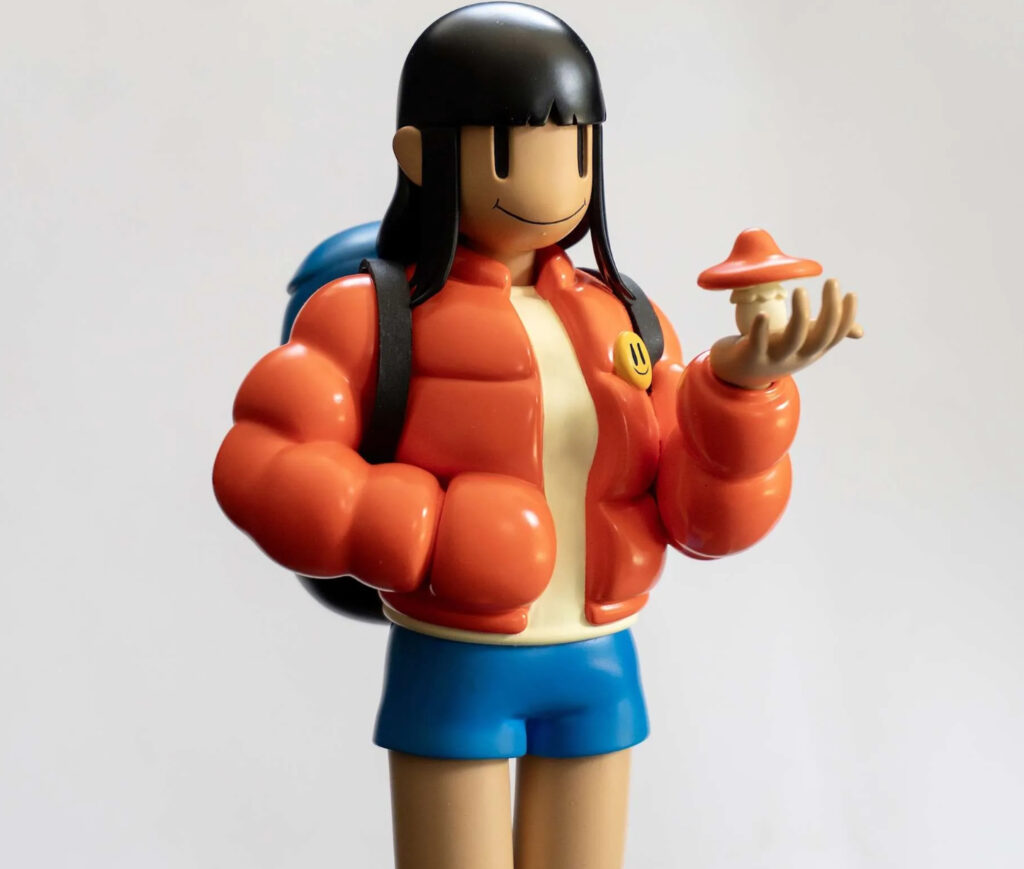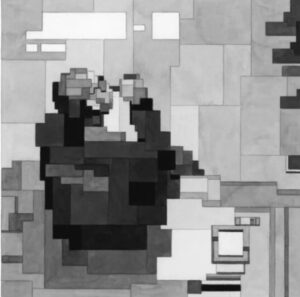In a cultural moment when creative boundaries are dissolving faster than ever, few projects so confidently leap into the aesthetic void like Alice by Mcbaise—the moody, funky, analog-drenched musical brainchild of illustrator-musician McBess. More than a record, Alice is a swirling, interdimensional spectacle—a soundtracked multiverse filtered through vintage vibes, absurdist storytelling, custom toy design, and meticulously orchestrated world-building. Born from McBess’s idiosyncratic fusion of music, illustration, and satire, and realized in union with creative connection, Alice is less a release than a surrealist event.
This isn’t Mcbaise’s first foray into world-making. His previous works—Surf, Windowsill, and TUBES—have long blurred the lines between mellow soft rock and satirical commentary, a kind of yacht rock hallucination where half-naked cartoon men lounge beside pizza boxes and muscle cars, and existential dread is offset by buttery basslines. But with Alice, McBess plunges headfirst into the layered possibilities of storytelling, venturing far beyond album artwork or quirky merch into a spatially plotted experience that merges analog media, music video aesthetics, collectible design, and narrative architecture.
Mcbaise: An Analog Surrealist in a Digital Storm
To understand Alice, one must first understand Mcbaise—a project that began as a musical side-channel for McBess, known in the art world for his grotesquely charming illustrations that echo vintage advertising, Max Fleischer cartoons, and motorcycle garage culture. Mcbaise songs are deceptively smooth: their tempo laid-back, their instrumentation dreamy, their vocals aloof. But under the surface—like his artwork—lies a haunting introspection, laced with humor, distortion, and ennui.
McBess’s universe is one where nothing is quite serious, yet everything is soaked in detail. His characters eat too much, masturbate with melancholy, and lounge in repetitive loops of dissatisfaction. In many ways, Alice amplifies this ethos—it’s a psychedelic leap into escapism, nostalgia, and self-aware absurdity. And like all good escapes, it comes with its own rules, soundtrack, and merchandise.
The Soundtrack: Yacht Rock from Another Dimension
At the heart of Alice lies the record itself. Sonically, Alice channels Mcbaise’s signature sound: a blend of 70s-tinged psych-pop, soft rock, and French funk—all heavily filtered through lo-fi production values that recall reel-to-reel tape hiss and dusty stereo systems. The album opens with “Gluten,” a track that immediately sets the tone—grooving basslines, echoed falsetto, and lyrics that oscillate between existential self-satire and hyper-specific absurdity.
But Alice is not just a soundtrack in the traditional sense. The music is embedded with narrative triggers. Each track, paired with visual elements and interludes, contributes to the overarching fiction of the Alice multiverse. This is not a concept album in the Pink Floyd sense, but something stranger—a layered, satirical trip through a meta-fictional space built on vintage aesthetic, circular logic, and jazz chords.
“Wife’s Corvette,” for example, spins a vignette of ego, erotic longing, and suburban delusion, while “Meatroom” plunges deeper into the surreal—channeling psychedelic breakdowns amid shimmering synth work. There’s narrative logic here, but it’s fuzzy, like recalling a dream through a VHS tape.
The Toy as Portal: Alice in Plastic Form
One of the most compelling components of the Alice project is its accompanying vinyl toy, produced in collaboration with Grit Combinator, a creative collective specializing in object design, media speculation, and world-building. The Alice figure is not merely merchandise—it’s a physical artifact from the world Mcbaise inhabits. Standing just under seven inches tall, the character (Alice herself?) is rendered with McBess’s signature monochrome lines, a distorted grin, and limbs frozen in a liminal pose between dance and glitch.
This toy acts as an artifact of the multiverse—not a mascot but a node, a cross-medium anchor for a narrative that moves between auditory hallucination and tactile fiction. Within Mcbaise’s world, toys don’t just sell records—they expand timelines. In this case, Alice the toy might just be the embodiment of Alice the story—looped in plastic, caught mid-jam in a groove she’ll never quite escape.
Grit Combinator’s involvement isn’t surface-level branding. Known for conceptual storytelling and physical media experiments, the collective brings a design approach that treats every object as part of a grander narrative continuum. Their collaboration ensures that Alice isn’t just music and merch—it’s ecosystemic.
A Visual Language: VHS Dreams, Liquor Ads, and Looping Fever Dreams
Visually, Alice is a retrofuturist dreamscape. The videos, social teasers, and visual art created for the release bleed together in a palette of burnt reds, tobacco-stained grays, and exaggerated body proportions. There’s a visual narrative to Alice, but it resists linearity. Instead, McBess serves up modular vignettes: a character eating too much ham, another floating through space in a bathtub, or a face distorted by analog screen flicker.
Like a malformed infomercial from another dimension, the visuals seem sourced from a timeline where French cable television was colonized by Talking Heads aesthetics and adult swim absurdism. The aesthetic grammar is consistent: fuzzy filters, looping animations, excessive labels on mundane products, and environments that collapse into themselves.
The video for the title track, “Alice,” functions as a Rosetta Stone to the project. In it, the titular character wanders through a looping dreamworld of soft drinks, misplaced lust, failed friendships, and static electricity—each scene more saturated in bittersweet funk than the last. Alice, we realize, is not just a name but an archetype: of obsession, confusion, and misplaced yearning.
Multiverse Mechanics: Fragmented Timelines and Circular Narratives
What elevates Alice beyond concept album or even multimedia project is its structural ambition. It mimics a multiverse not just in theme but in narrative format. There are no definitive interpretations—just fragments. Alice is a person, a toy, a song, and an aesthetic. She is the throughline across temporal glitches and character recurrences. In one video she’s dancing in a shopping mall; in another, she’s a beverage mascot. Always present, never static.
Mcbaise achieves this not through exposition but through repetition and modularity. Characters return across songs and visuals. The same apartments are drawn again with minor changes. Snippets of audio appear distorted and reversed in later tracks. It’s storytelling via resonance rather than progression.
And like any good multiverse, the chaos is intentional. Alice doesn’t resolve. It spirals. Each format—vinyl record, toy, video, zine—feeds into the next, like a Möbius strip wrapped around a pizza crust.
Grit Combinator: From Collaboration to Co-Authorship
The fingerprints of Grit Combinator are deeply embedded in this project. Known for crossing disciplines—architecture, design fiction, speculative media—the group treats culture not as finished product but as feedback loop. Their presence in Alice is not incidental but vital. The toy’s packaging includes excerpts from a fictional manual, QR codes that lead to non-linear digital environments, and schematics that make no literal sense but feel narratively loaded.
With McBess, Grit Combinator operates in full synergy, treating music as lore, and illustration as cartography. The collaborative process mirrors a jazz ensemble: structured yet improvised, intentional but open-ended. Together, they architect not just a release, but a reality-bending fiction factory—complete with blueprints, artifacts, and sonic detritus.
The Vibe Overload: Intoxication as Narrative Logic
If Alice had a genre beyond music, it would be aesthetic intoxication. The project is built on overload—of texture, tone, absurdity, and mood. It weaponizes nostalgia, but not for a specific time. Rather, it conjures memory as feeling—a vague longing for a past that never happened, filtered through greasy lens flares and cracked cassette cases.
Mcbaise’s music has always lived in this terrain. His lyrics reference food, failed relationships, masturbation, forgotten cars, and empty promises. Yet they arrive coated in such smooth harmonics, such buttery Rhodes progressions, that the listener often sways rather than questions. Alice expands this contradiction until it becomes its own logic: a trip that knows it’s a trip, and leans in harder.
This isn’t satire. It’s not irony. It’s commitment to the bit—total aesthetic immersion in a fictionalized psyche where longing, humor, and sonic craftsmanship collide in beautifully useless ways.
Flow
Alice is a multiverse not just in theme but in methodology. It shows how fiction, when layered with music, physical design, and visual coherence, can achieve something emotionally true—even when its pieces are absurd. Mcbaise and Grit Combinator have not just made an album or a toy or a video—they’ve created a system of vibes, a world where meaning isn’t found but assembled through repetition, tone, and texture.
In a landscape saturated with fast content and algorithmic blandness, Alice is a reminder of what happens when artists stop asking what they should make and start building the weird, gorgeous things only they can see. A toy. A dream. A band. A glitch. A girl named Alice.
Somewhere in the multiverse, she’s still dancing. Maybe we are too.
No comments yet.







